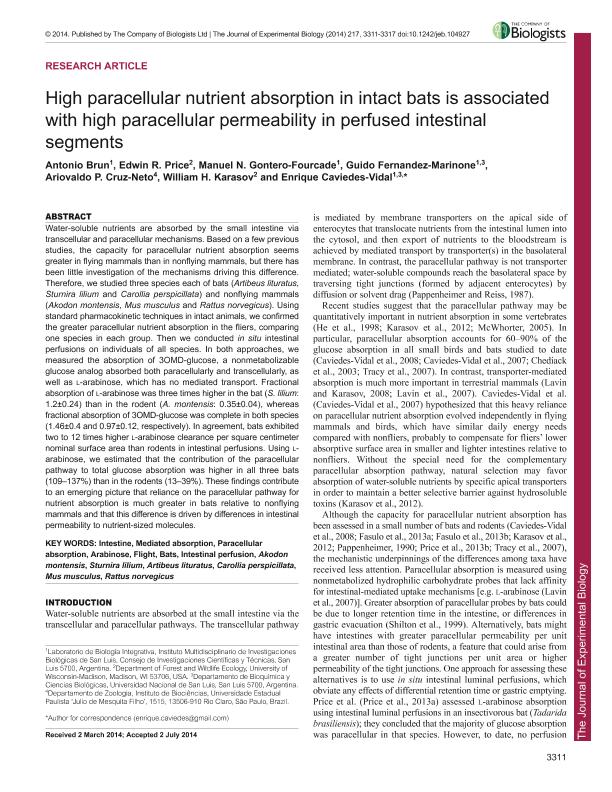Mostrar el registro sencillo del ítem
dc.contributor.author
Brun, Antonio

dc.contributor.author
Price, Edwin R.
dc.contributor.author
Gontero Fourcade, Manuel Nicolas

dc.contributor.author
Fernández Marinone, Guido

dc.contributor.author
Cruz Neto, Ariovaldo P.
dc.contributor.author
Caviedes Vidal, Enrique Juan Raul

dc.contributor.author
Karasov, William H.
dc.date.available
2017-04-03T17:35:17Z
dc.date.issued
2014-07
dc.identifier.citation
Brun, Antonio; Price, Edwin R.; Gontero Fourcade, Manuel Nicolas; Fernández Marinone, Guido; Cruz Neto, Ariovaldo P.; et al.; High paracellular nutrient absorption in intact bats is associated with high paracellular permeability in perfused intestinal segments; Company of Biologists; Journal of Experimental Biology; 217; 18; 7-2014; 3311-3317
dc.identifier.issn
0022-0949
dc.identifier.uri
http://hdl.handle.net/11336/14686
dc.description.abstract
Water-soluble nutrients are absorbed by the small intestine via transcellular and paracellular mechanisms. Based on a few previous studies, the capacity for paracellular nutrient absorption seems greater in flying mammals than in nonflying mammals, but there has been little investigation of the mechanisms driving this difference. Therefore, we studied three species each of bats (Artibeus lituratus, Sturnira lilium and Carollia perspicillata) and nonflying mammals (Akodon montensis, Mus musculus and Rattus norvegicus). Using standard pharmacokinetic techniques in intact animals, we confirmed the greater paracellular nutrient absorption in the fliers, comparing one species in each group. Then we conducted in situ intestinal perfusions on individuals of all species. In both approaches, we measured the absorption of 3OMD-glucose, a nonmetabolizable glucose analog absorbed both paracellularly and transcellularly, as well as l-arabinose, which has no mediated transport. Fractional absorption of l-arabinose was three times higher in the bat (S. lilium: 1.2±0.24) than in the rodent (A. montensis: 0.35±0.04), whereas fractional absorption of 3OMD-glucose was complete in both species (1.46±0.4 and 0.97±0.12, respectively). In agreement, bats exhibited two to 12 times higher l-arabinose clearance per square centimeter nominal surface area than rodents in intestinal perfusions. Using l-arabinose, we estimated that the contribution of the paracellular pathway to total glucose absorption was higher in all three bats (109–137%) than in the rodents (13–39%). These findings contribute to an emerging picture that reliance on the paracellular pathway for nutrient absorption is much greater in bats relative to nonflying mammals and that this difference is driven by differences in intestinal permeability to nutrient-sized molecules.
dc.format
application/pdf
dc.language.iso
eng
dc.publisher
Company of Biologists

dc.rights
info:eu-repo/semantics/openAccess
dc.rights.uri
https://creativecommons.org/licenses/by/2.5/ar/
dc.subject
Intestine
dc.subject
Mediated Absorption
dc.subject
Paracellular Absorption
dc.subject
Arabinose
dc.subject
Bats
dc.subject
Flight
dc.subject
Intestinal Perfusion
dc.subject
Akodon Montensis
dc.subject
Sturnira Lilium
dc.subject
Artibeus Lituratus
dc.subject
Carollia Perspicillata
dc.subject
Mus Musculus
dc.subject
Rattus Norvegicus
dc.subject.classification
Otras Ciencias Biológicas

dc.subject.classification
Ciencias Biológicas

dc.subject.classification
CIENCIAS NATURALES Y EXACTAS

dc.title
High paracellular nutrient absorption in intact bats is associated with high paracellular permeability in perfused intestinal segments
dc.type
info:eu-repo/semantics/article
dc.type
info:ar-repo/semantics/artículo
dc.type
info:eu-repo/semantics/publishedVersion
dc.date.updated
2016-11-24T19:24:38Z
dc.identifier.eissn
1477-9145
dc.journal.volume
217
dc.journal.number
18
dc.journal.pagination
3311-3317
dc.journal.pais
Reino Unido

dc.journal.ciudad
Cambridge
dc.description.fil
Fil: Brun, Antonio. Consejo Nacional de Investigaciones Científicas y Técnicas. Centro Científico Tecnológico San Luis. Instituto Multidisciplinario de Investigaciones Biológicas de San Luis; Argentina
dc.description.fil
Fil: Price, Edwin R.. University Of Wisconsin; Estados Unidos
dc.description.fil
Fil: Gontero Fourcade, Manuel Nicolas. Consejo Nacional de Investigaciones Científicas y Técnicas. Centro Científico Tecnológico San Luis. Instituto Multidisciplinario de Investigaciones Biológicas de San Luis; Argentina
dc.description.fil
Fil: Fernández Marinone, Guido. Consejo Nacional de Investigaciones Científicas y Técnicas. Centro Científico Tecnológico San Luis. Instituto Multidisciplinario de Investigaciones Biológicas de San Luis; Argentina. Universidad Nacional de San Luis. Facultad de Quimica, Bioquimica y Farmacia. Departamento de Bioquímica y Ciencias Biológicas; Argentina
dc.description.fil
Fil: Cruz Neto, Ariovaldo P.. Universidade Estadual Paulista Julio de Mesquita Filho; Brasil
dc.description.fil
Fil: Caviedes Vidal, Enrique Juan Raul. Universidad Nacional de San Luis. Facultad de Quimica, Bioquimica y Farmacia. Departamento de Bioquímica y Ciencias Biológicas; Argentina. Consejo Nacional de Investigaciones Científicas y Técnicas. Centro Científico Tecnológico San Luis. Instituto Multidisciplinario de Investigaciones Biológicas de San Luis; Argentina
dc.description.fil
Fil: Karasov, William H.. University of Wisconsin; Estados Unidos
dc.journal.title
Journal of Experimental Biology

dc.relation.alternativeid
info:eu-repo/semantics/altIdentifier/url/http://jeb.biologists.org/content/217/18/3311
dc.relation.alternativeid
info:eu-repo/semantics/altIdentifier/doi/http://dx.doi.org/10.1242/jeb.104927
Archivos asociados
